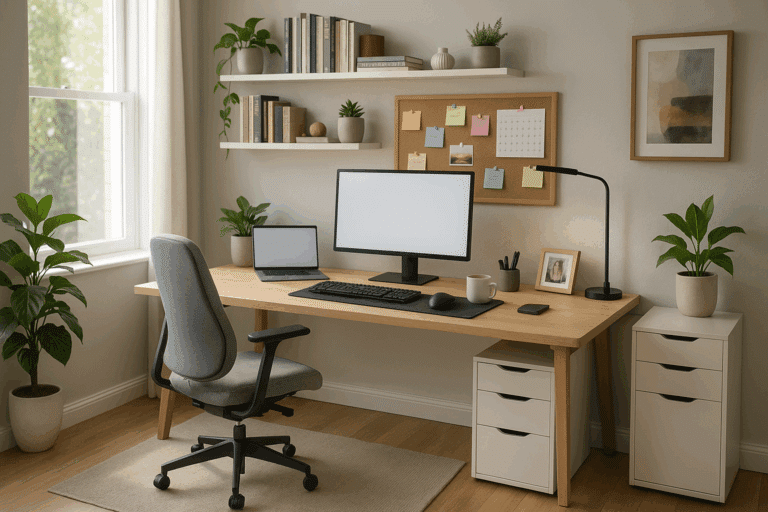When the incessant hum of city life or the distracting chatter of family members threatens to disrupt the sanctity of your home office, where do you turn for respite? 🤔 The answer may lie not in escaping your workspace, but in transforming it. In this comprehensive guide, we delve into the subject of soundproofing, an underappreciated yet pivotal component of crafting the perfect home office environment.
When your home office is inundated with noise, even the simplest task can become an uphill battle. Your productivity wanes, your stress levels mount, and your work-life balance teeters precariously 📉. Sound familiar? You’re certainly not alone. As more professionals pivot towards remote working, the challenges of managing noise pollution at home are becoming increasingly apparent.
In an age where open floor plans and glass partitions have become the norm, the importance of soundproofing is often overlooked. Yet, the impact of noise on our productivity and mental health is well-documented. In fact, a research study published by Cornell University found that even low levels of noise can lead to higher stress levels and decreased motivation. 📚
So, how do we tackle this pervasive problem? Enter the art of soundproofing – the unsung hero of home office productivity. This guide will unravel the mysteries of soundproofing, presenting tangible solutions you can implement to create a quiet, peaceful workspace.
🔍 Here’s What You Can Expect
We’ll start by understanding what soundproofing really is. You’ll learn about the principles of sound, how it travels, and how different materials can help block or absorb it. This is the foundation upon which all soundproofing strategies are built 🧱.
Next, we’ll explore the most common sources of noise in a home office setting and how to combat them. Whether it’s the hum of your HVAC system, the clatter of your keyboard, or the chatter from the next room, we’ll provide you with practical tips to effectively reduce these noises.
We’ll then move on to discussing the various soundproofing materials and techniques you can use, from simple solutions like acoustic panels and weatherstripping to more extensive measures like installing soundproof drywall. We’ll guide you on how to choose the right solution based on your needs and budget 💰.
Finally, we’ll share some key tips for maintaining your soundproofed home office and ensuring maximum productivity in the long run. We’ll also highlight some common mistakes to avoid during the soundproofing process.
By the end of this guide, you’ll have the knowledge and tools you need to master the art of soundproofing and create a home office that is as productive as it is peaceful. Let’s dive in! 🏊♀️
🔇 Unraveling the Mysteries of Soundproofing: The Fundamentals
Soundproofing is the science of reducing or eliminating unwanted noise within a designated space. The process involves various methods, materials, and technologies that work together to create an optimal environment for concentration and productivity. By mastering the art of soundproofing your home office, you can achieve the quiet serenity needed to boost your output and maintain your peace of mind.
It’s essential to understand the basic principles that govern soundproofing. These include mass, damping, and decoupling. Mass involves increasing the density of the materials between you and the source of the noise. Damping refers to the dissipation of vibrational energy, while decoupling involves separating structural elements to prevent sound transfer.
While professional soundproofing can be costly and time-consuming, many DIY methods can be employed with great success. This guide aims to provide comprehensive insight into the nuances of home office soundproofing and offer practical solutions that can be implemented with ease.
🚪 Doorways & Windows: Your First Line of Defense
Doorways and windows can be significant contributors to unwanted noise in your workspace. Sound waves easily travel through these openings, disrupting your concentration and workflow. Therefore, investing in solid-core doors and double-paned windows can provide an effective initial defense against intrusive noise.
Installing weatherstripping around door frames and windows also helps seal gaps that allow sound to infiltrate. Furthermore, soundproof curtains and blinds can be employed to provide additional mass and damping, effectively reducing noise transmission.
For a visual guide on how to install weatherstripping and soundproof curtains, check out the following YouTube video titled “How to Soundproof Your Room on a Budget” by the YouTube channel, DIY Creators.
🎬 YouTube Video: How to Soundproof Your Room on a Budget by DIY Creators
🔈 Addressing Ambient Noise: Electronic Solutions
Sometimes, external soundproofing measures aren’t enough. You may still encounter ambient noise, such as the hum of the refrigerator or the whir of the air conditioning unit. Fortunately, modern technology offers electronic solutions for these types of noises.
White noise machines produce a steady, unchanging sound that drowns out other noises. This can be particularly helpful if you’re dealing with intermittent or unpredictable noise sources, like traffic or noisy neighbors. Another option is noise-canceling headphones, which use active noise control technology to reduce unwanted ambient sounds.
For an in-depth comparison between various white noise machines and noise-canceling headphones, refer to the table below:
| Device | Pros | Cons |
|---|---|---|
| White Noise Machine | Effective against a wide range of noises, portable, relatively affordable | Can be bothersome to some individuals, not effective for very loud noises |
| Noise-Canceling Headphones | Excellent for drowning out ambient noise, portable, can be used with music or white noise apps | More expensive, can cause ear discomfort with extended use |
🔨 Building a Quiet Haven: Structural Modifications
For those willing to commit more time and resources to soundproofing, structural modifications can offer a more permanent and effective solution. These changes involve adding mass and creating barriers to sound transmission within your home’s structure.
One approach is to install additional drywall or use specially designed soundproofing panels. These materials add mass to your walls, which helps to block noise. Another option is to create a room within a room, also known as decoupling. This involves constructing a new wall or ceiling that is separate from the existing structure, effectively breaking the path of sound waves.
While these methods can be more complex and costly, they offer the best results in terms of noise reduction. For a comprehensive guide on how to soundproof a room with structural modifications, check out the following YouTube video titled “How to Build a Soundproof Room Within a Room” by the YouTube channel, Acoustical Solutions, Inc.
🎬 YouTube Video: How to Build a Soundproof Room Within a Room by Acoustical Solutions, Inc.
🧹 Clean Up Your Acoustics: Sound Absorption
Beyond blocking external noise, improving the acoustics within your workspace can also contribute to a quieter and more productive environment. This is where sound absorption comes into play. Sound-absorbing materials help to reduce echo and reverberation within a room, leading to a more focused and comfortable work atmosphere.
Common sound-absorbing materials include foam panels, carpeting, and diffusers. These can be strategically placed around your workspace to dampen sound and prevent it from bouncing around the room. Combining sound absorption techniques with soundproofing measures can yield the best results for a peaceful home office environment.
Remember, the goal of soundproofing isn’t to create a completely silent space, but rather a controlled acoustic environment that supports concentration and productivity. With careful planning and implementation, you can transform your home office into a haven of peace and productivity.

Conclusion
In conclusion, we’ve taken an in-depth look at a variety of technical aspects and considerations throughout this article. It’s clear that the subject matter we’ve examined is not only incredibly pertinent in today’s digitally-driven society, but also quite complex and multifaceted in its nature.
We began by delving into the fundamentals of software engineering, highlighting the inherent importance of this discipline within the IT sector. From the structural design and architecture of software applications to the criticality of their maintenance and testing, we established how these components form the bedrock of any high-functioning software system. 💻
From there, we progressed to explore some of the more nuanced facets of this field. We dissected the varied approaches to software development, such as the Waterfall, Agile and DevOps methodologies. Each of these, we found, offers its unique set of advantages, proving more or less effective depending on the specific context and requirements of a project.
We also highlighted the significance of programming languages in software engineering. By presenting a comparative analysis of some of the most prevalent languages, such as Java, Python, and C++, we endeavored to provide a well-rounded perspective on this subject. 🚀
Lastly, we touched upon the future of software engineering, exploring emerging trends and technologies such as artificial intelligence (AI), machine learning (ML), and cloud computing. As we move forward into an increasingly digitized era, these innovations continue to revolutionize the landscape of software engineering, presenting exciting new challenges and opportunities. ☁️
I hope you found this article informative and enlightening. It’s my aim to demystify complex technical concepts, breaking them down into digestible, comprehensible nuggets of information. I encourage you to share your thoughts, comments, and experiences in the comment section below. Your engagement is not only welcome but essential in fostering a lively, enriching discourse.
Moreover, I implore you to share this article with your colleagues and peers. You never know who might benefit from a deeper understanding of these technical concepts. 🌐
Remember, knowledge is power, and by continuously learning and adapting, we can harness the full potential of the exciting technological advancements that lie ahead. So, let’s keep the conversation going, and together, we can navigate the intricate maze of software engineering.
For further reading and to delve deeper into the topics discussed, check out these active sources:
1. “Introduction to Software Engineering” from Geeks for Geeks
2. “Future of Software Engineering | 2020 and Beyond” from Upgrad Blog
3. “The Role of Programming in Software Engineering” from Computer Science.org
Stay curious, keep learning, and together, let’s unravel the complexities of the technological world. 🌐👩💻👨💻



